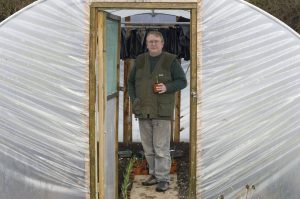What to sow, plant and harvest from your polytunnel in February
In your greenhouse or tunnel you may now be fooled that spring has arrived. Your tunnel or greenhouse can easily warm up to 20˚C during sunny spells. You also notice that the days are getting longer and your gardening itch is starting up again.
 Anything you have missed from the January Polytunnel section can still be done now, it will be even safer. February is also the time to sow all your exciting warmth loving Mediterranean vegetables – tomatoes, peppers, chillies and aubergines.
Anything you have missed from the January Polytunnel section can still be done now, it will be even safer. February is also the time to sow all your exciting warmth loving Mediterranean vegetables – tomatoes, peppers, chillies and aubergines.
Sowing in the Polytunnel
Direct sowing into bed
All throughout February you can sow the following vegetables directly into the beds:
- Beetroot (Pablo F1, Boltardy)
- Carrots (Namur F1, Amsterdam Forcing)
- Oriental brassica salads (various types)
- Peas, Mangetout (Sweet Horizon)
- Radish (Short Top Forcing) – small quantities at regular intervals
- Turnips (Milan Purple Top) – small quantities at regular intervals
Planting into beds
Throughout the month you can still plant the first early chitted potatoes (Homeguard or Sharpe’s Express). Don’t forget to cover the shoots with fleece during frosty weather.
You can still plant early strawberries into your tunnel or greenhouse.
Early spring planted garlic can be planted now.
Sowing into modules/pots (18-20˚C)
In February you can sow the following vegetables into modular trays and place them in your propagator or warm, south facing windowsill in the house:
- Aubergine (Black Prince F1) – 5 seeds per 7cm pot, for pricking out
- Cabbage (Hispi F1 or Pyramid F1) – 1 seed per cell
- Calabrese (Green Magic F1) – 1 seed per cell
- Cauliflower (for mini cauliflowers) – 1 seed per cell
- Celery (Victoria F1) – broadcast in a tray for pricking out later
- Chilli peppers (various varieties) – 5 seeds per 7cm pot
- Coriander, Dill and Chervil – 5 seeds per cell
- Kohlrabi (Azur Star) – 1 seed per cell
- Leeks (Roxton F1) – 2 seeds per cell
- Lettuce (various types) – 1 to 3 seeds per cell
- Mangetout peas (Sweet Horizon) – 4 seeds per 7cm pots
- Onions (Golden Bear F1) – 4 seeds per cell
- Oriental salads (mizuna, rocket, tatsoi, etc.) – 5 seeds per cell
- Pepper (Roberta F1, Bell Boy F1) – 5 seeds per 7cm pot, for pricking out
- Perpetual spinach and Swiss Chard – 1 seed per cell
- Scallions (Parade or Ishikura) – 5 to 10 seeds per cell, depending on how many you like in a bunch
- Tomato (Sungold F1 & others) – 5 seeds per 7cm pot, for pricking out
Harvesting from the Polytunnel
As the daylength increases in February your overwintering salads are starting to come into their own. You may even have a glut and enough for the whole neighbourhood. The over-wintered perpetual spinach and Swiss chard are also cropping well now.
You can harvest:
Salad rocket, wild rocket, various mustard leaves (Green Wave, Green in the snow, Red Frills, Green Frills), tatsoi, pak choi, corn salad, winter purslane, cress, mizuna, mibuna, komatsuna, texel greens, baby spinach, beet leaves (Bulls Blood) and possibly even some lettuce leaves.
General greenhouse/polytunnel maintenance
- Water lightly, once per week.
- Ventilate as much as possible.
- Continue planning. The more organised you are the less work there will be later.
- It’s a good time to dig in well-rotted manure or compost into empty beds. Remember each bed needs to be fed every year. Do not manure the carrot bed – it’s better to do it after the carrots are harvested.
- Cover up the emerging potato shoots with fleece or cover completely with soil if frost is forecast.
- Clean and wash plastic or glass and all pots and trays if you haven’t done so earlier.
- Replace cracked panes of glass and repair any rips in the plastic with special tape.
- Set up your heating bench and replace the sand.
- You can pre-warm the soil by covering some empty beds with black plastic especially if you plan to direct sow an early crop.
Further Information & Polytunnel Articles
- How to maintain and repair your polytunnel
- Polytunnels & Organic Growing in a Polytunnel
- Polytunnels for Productivity
- Growing in a Polytunnel in January
- Growing in a Polytunnel in February
- Growing in a Polytunnel in March
- Growing in a Polytunnel in April
- Growing in a Polytunnel in May
- Growing in a Polytunnel in June
- Growing in a Polytunnel in July
- Growing in a Polytunnel in August
- Growing in a Polytunnel in September
- Growing in a Polytunnel in October
- Growing in a Polytunnel in November
- Growing in a Polytunnel in December




